It’s one thing to have a mean streak; it’s quite another to practice cruelty so extreme that it borders on sadism. Yet, Robert McKimson created a bulldog displaying that exact trait – and still got laughs!
Because several bulldogs appeared in Looney Tunes cartoons and their names seem to be interchangeable (Spike, Hector, or Butch), some confusion exists. I will attempt to clarify here: “Hector,” or a dog called by that name, was primarily used by Friz Freleng as a foil to Sylvester the cat and was a pet of Granny’s. He was usually depicted wearing a collar and was often tan in color. A bulldog called “Spike” wearing a red sweater appeared with Chester the pup in Tree for Two (1952), also directed by Freleng. Chuck Jones’ bulldog Marc Anthony was dark brown and more canine in behavior, as seen in Feed the Kitty (1952).
McKimson’s brutal gray bulldog went unnamed during his career in six cartoons from 1948-1951, all directed by McKimson. He first appeared in The Up-Standing Sitter and was called “Spike” in that cartoon but later became known as “The McKimson Dog” or “The Talking Bulldog.” McKimson seems to have created his own bulldog unrelated to the other Warner pooches., although by this point, he may have answered to any of the above names! One thing, however, is clear: this dog knows some nasty tricks.
The Talking Bulldog was a main character in It’s Hummer Time (LT# 1122), his fourth appearance. His opponent, or rather, victim, is a tuxedo cat also exclusive to Mc Kimson. He first appeared in the 1949 Porky Pig short Paying the Piper as the “Supreem Cat” and continued to be tagged with that name (with the spelling corrected to “Supreme”) in subsequent cartoons. McKimson would use the character six times between 1949 and 1951.
We focus here on two cartoons made a year apart from 1950 (It’s Hummer Time) to 1951 (Early to Bet) that are thematically similar and equally hilarious. What set these toons apart was a unique structure based on actions/consequences carried out to extremes Tex Avery might have admired.
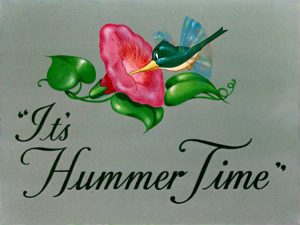 It’s Hummer Time featured the cat annoying the bulldog while in pursuit of a hummingbird. In a brilliant piece of foreshadowing, the cat has disguised himself as a birdbath. In any other cartoon, this might have resulted in a face punch or board whack, but the bulldog has a repertoire of dreadful punishments already established for the cat. To make things funnier the cat is seemingly aware of all of them, including their fiendishly clever names, but submits to them anyway!
It’s Hummer Time featured the cat annoying the bulldog while in pursuit of a hummingbird. In a brilliant piece of foreshadowing, the cat has disguised himself as a birdbath. In any other cartoon, this might have resulted in a face punch or board whack, but the bulldog has a repertoire of dreadful punishments already established for the cat. To make things funnier the cat is seemingly aware of all of them, including their fiendishly clever names, but submits to them anyway!
For the “crime” of landing atop the bulldog’s doghouse, the cat is nabbed and begins screaming, “No! Not The Fence!” The cat’s tail is pulled through a knothole, along with the rest of him. A constant feature of the punishments is the calm, businesslike demeanor of the bulldog as Raymond Scott’s composition “Powerhouse” accompanies his actions.
It gets worse. Trapping the bulldog’s head in a butterfly net earns the cat “Happy Birthday”: The dog sets a table, puts a party hat on the disgusted cat, and gives him a noisemaker. There is even a sign and a wreath of flowers in the background with birthday congratulations! A cake with dynamite candles is then put before the cat…
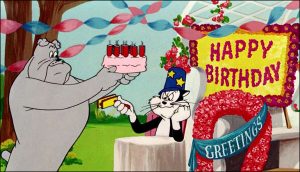 The cat mistakenly lands the bulldog with a fishing rod, and it’s “No! Not The Rainpipe!” It’s a painful trip down…but nothing compared to “The Thinker,” after the dog discovers the cat in his bowl of bones. The cat is thrown into a cement mixer (which even has a pre-set button for “The Thinker.” The cat is ejected in the form of Auguste Rodin’s famous statue.
The cat mistakenly lands the bulldog with a fishing rod, and it’s “No! Not The Rainpipe!” It’s a painful trip down…but nothing compared to “The Thinker,” after the dog discovers the cat in his bowl of bones. The cat is thrown into a cement mixer (which even has a pre-set button for “The Thinker.” The cat is ejected in the form of Auguste Rodin’s famous statue.
Thinking the bulldog has swallowed the hummingbird, the cat makes his worst error by using sneezing powder and is sentenced to “The Works.” “Don’t do it! In the name of humanity!” cries the cat. “The Works” combines every punishment shown plus some, but the hummingbird is just as sadistic. Unseen, he ties the dog’s leg to the same rope the cat is tied to, and both cat and dog get the punishment! To the delight of the bird, both enemies are now a cement birdbath.
McKimson’s comic sensibilities are as present as they were in many of his Foghorn Leghorn cartoons, especially in the battles between Foghorn and Barnyard Dawg. The contributions of Warren Foster, who wrote the story, put this cartoon over the top. Foster had the distinction of writing for three of Warner’s top directors, Bob Clampett, Robert McKimson, and Friz Freleng.
The opening sequence, animated by an uncredited Emery Hawkins, introduces the hummingbird, the straw that stirs the drink. Rod Scribner and Phil De Lara animated “The Fence” punishment. The celebrated “Happy Birthday” sequence was animated by Charles McKimson, Robert’s talented brother.
John Carey animated the rainpipe punishment and much of the dog and cat getting “The Works,” with Rod Scribner ending the scene. J.C. Melendez animated additional scenes.
The cat’s manic, pleading vocals, which is, to say, most of the film’s dialogue, were provided by Mel Blanc. Besides his arrangement of “Powerhouse,” Carl Stalling contributed bits of popular music, including “I’m Looking Over a Four-Leaf Clover” as the hummingbird’s theme. Richard H. Thomas and Cornett Wood teamed up on the soft backgrounds and layouts. Treg Brown (uncredited) contributed sound effects.
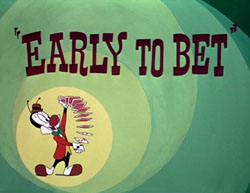 But the bulldog’s fun and the cat’s misery were far from over. In Early to Bet (LT# 1159), The cat is a victim of The Gambling Bug, a one-shot character created and designed by Charles McKimson. The Bug is a dapper figure with a derby hat, red jacket, and yellow vest. A simple bite from the Bug, as evidenced in an opening montage, results in a compulsive need to bet – on anything!
But the bulldog’s fun and the cat’s misery were far from over. In Early to Bet (LT# 1159), The cat is a victim of The Gambling Bug, a one-shot character created and designed by Charles McKimson. The Bug is a dapper figure with a derby hat, red jacket, and yellow vest. A simple bite from the Bug, as evidenced in an opening montage, results in a compulsive need to bet – on anything!
In this cartoon, the bulldog needs no provocation; he is a card sharp of the highest order. He tries to entice the cat to play gin rummy for “penalties,” but the cat is wise to him and refuses…until the Gambling Bug bites his ear! The frantic cat runs to the dog, demanding to play him in a frenzied scene animated by Emery Hawkins. The dog wins without playing a single card, and we learn the meaning of “penalties.”
To the mocking tune of “Blues in The Night,” the cat spins a numbered penalty wheel. He draws a card from a file cabinet with the corresponding number 14. “No! Not the Gesundheit!” “Powerhouse” is again used as the soundtrack as Rod Scribner animates this deadly mixture of bubble gum and sneezing powder that leaves the cat coated in sticky gum.
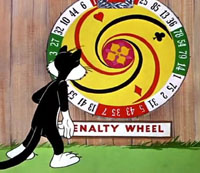 The Gambling Bug isn’t done with the cat yet. With another bite and an exhortation, the cat returns for another game with predictable results. Penalty #75 is “William Tell,” which involves the bulldog’s archery bow shooting a toilet plunger over the cat’s face. The bulldog is wearing a Robin Hood cap, an added comic touch by writer Warren Foster.
The Gambling Bug isn’t done with the cat yet. With another bite and an exhortation, the cat returns for another game with predictable results. Penalty #75 is “William Tell,” which involves the bulldog’s archery bow shooting a toilet plunger over the cat’s face. The bulldog is wearing a Robin Hood cap, an added comic touch by writer Warren Foster.
The Gambling Bug means well; he wants the cat to win and bites him again. Do you think the cat wins this time? Penalty #36 has the cat jerking in spasms of fear, again the masterful work of Hawkins. “Roll Out The Barrel is a terrifying attempt to outrace a leaking barrel of gunpowder, and the cat is blown sky-high, animated by Phil DeLara.
The bulldog refuses to play further: “Yer too unlucky, cat. I’m quittin’ before ya kills yerself!” That leaves the cat to play with the Gambling Bug, who cuts a lower card than the cat. As the short ends, the Bug frantically dodges the cat’s newspaper: “No! Not the Post!” Phil DeLara animated that final scene. John Carey was an uncredited animator.
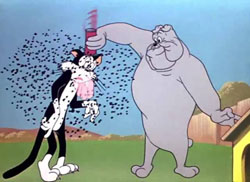 Mel Blanc supplied all the voices, save for that of the Gambling Bug, who uncredited comic actor Stan Freberg voiced. Carl Stalling handled the music and Richerd H. Thomas and Cornett Wood again collaborated on backgrounds and layouts. Please read Devon Baxter’s animator breakdown for this cartoon, HERE.
Mel Blanc supplied all the voices, save for that of the Gambling Bug, who uncredited comic actor Stan Freberg voiced. Carl Stalling handled the music and Richerd H. Thomas and Cornett Wood again collaborated on backgrounds and layouts. Please read Devon Baxter’s animator breakdown for this cartoon, HERE.
This pair of cartoons has an enormous cult following among Looney Tunes fans and influenced pop culture. In 1986, sixteen years after It’s Hummer Time, comic book artist (and animation fan) John Byrne wrote and illustrated issue #3 of Man of Steel. In that comic, villainess Magpie paralyzes a hapless henchman and shoves a stick of dynamite into his mouth while another horrified henchman in the background screams:
“Oh, no, boss! Not “Happy Birthday! Not “Happy Birthday!”
Well, at least the Supreme Cat only got splattered with cake…



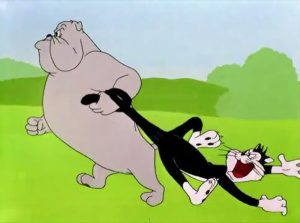
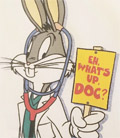 Martin Goodman is a veteran writer specializing in stories about animation. He has written for AWN and Animation Scoop – and lives in Anderson, Indiana.
Martin Goodman is a veteran writer specializing in stories about animation. He has written for AWN and Animation Scoop – and lives in Anderson, Indiana.



























The third segment of the 1983 anthology film “Twilight Zone: the Movie” was a remake of what, for my money, was the single most frightening episode of the original TV series: “It’s a Good Life”, based on Jerome Bixby’s 1953 science fiction/horror short story. In the movie version, all-powerful young Anthony is obsessed with cartoons, ranging from “Bimbo’s Initiation” to “The Power of Thought”, which play constantly on TV screens in the background and provide a wry counterpoint to the main scenario. When Anthony announces that today is his birthday (as practically every day is, because he so wills it), we see a clip from “It’s Hummer Time” of the bulldog calmly leading the cat to its fate as the latter wails: “No! Not Happy Birthday! No! Not that! Please! No! NOT HAPPY BIRTHDAY!” As funny as the clip is in its original context, here it conveys a horrific sense of impending doom as the adults in the scene find themselves trapped in a nightmare world of cartoons come to life.
I’ve long felt that McKimson’s best work is on a par with the best of Freleng, Jones, Avery or Clampett. The two cartoons profiled here offer strong support for that view.
My favorite minor Looney Tunes character. There’s just something amusing about how soft-spoken he is contrasting with the comic violence he casually dishes out.
He also appears in A Fox in a Fix (1951).
Change the cat to Matthew Perry, the current victim du jour (move over, Princess Diana), and the dog and the Gambling Bug will be arrested.
Come on, enough of this bad taste nonsense.
Two outstanding cartoons from director Robert McKimson.
Robert McKimson was usually given short shift in the Looney Tunes pantheon, but he’ll always be my favorite director. These hilarious shorts are a pair of very good reasons.
This is a series of cartoons that a lot of people remember, but nobody knows the names of. All that sticks with them are the punishments doled out to the cat and his protests of them. That shows just how good the Looney Tunes/Merrie Melodies series is as a whole, and especially short-term characters like these two and Ralph Phillips, or even characters that appear in only one or two cartoons, like Michigan J. Frog.
Always like the bulldog in “A Fox in a Fix” (1951) where a fox tries to trick the guard dog by posing as a new trainee guard dog as a ploy (which the bulldog see through but plays along anyway) to get some chickens. The ending is pretty hilarious.
Both of these are favorites, though they were vaguely disturbing to young kid me. Must have been Blanc’s pleas.
Typo above: “In 1986, sixteen years after It’s Hummer Time”, but 1986 is 36 years after 1950.
I wonder if the cat McKimson used in the late 40s/early 50s was indeed supposed to be the same character. The ‘Supreem’ cat in ‘Paying the Piper’ and ‘Swallow the Leader’ has the pudgy build McKimson’s Bugs had around this time, plus he wore a stiff collar (similar to Egghead/Elmer Fudd in their civilian attire). The cat that appears with the bulldog (and also in two shorts with Foghorn Leghorn) has no collar and has more gangly limbs.
The cat, at least the “Not That, not the…” skinny one, appeared in one, 1950, “A FRACTURED LEGHORN”,with Foghorn, but what other was he in?
In 2007’s “HAIRSPRAY”, released by WB thru New Line Cinema, young comic (pre-scandal) actress Amanda Bynes as ditzy teenager Penny Pingleton utters “Not the rope”, while being literally tied up in the basement by her mom (Allison Janney) as a segregationalist punishment! “Oh No, not the rope, not the rope!” HMM…
Steve C.
The other Foghorn short the cat appeared in was ‘Leghorn Swoggled’. He’s basically a cameo and only has one scene with Henery Hawk:
‘Hey cat, do you know where there’s a bone?’
‘Yes, and I’ll tell you if you get me a fish!’
Thanks..I remember that one.
McKimson had a thing for cruelty…
HIPPETY HOPPER (1949) was another short this bulldog appeared in, and with his trademark voice.
NOT HAPPY BIRTHDAY!
Though “Chow Hound” was a Chuck Jones short, it feeds right into this article. Every Thanksgiving we can’t wait to say “What? No Gravy?” and “This time, we DIDN’T forget the gravy!” – bwahahahaha